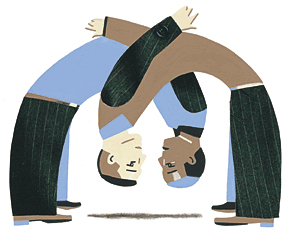
“Any society which is racially stratified has a fundamental problem with implementing democracy,” said Dr. Tukufu Zuberi, professor of sociology and director of Penn’s Afro-American Studies Program, during a recent talk sponsored by the Greenfield Intercultural Center. The lecture, “Evolving Dimensions of Race and Racism,” examined the ways in which race is studied and conceptualized.
Both Zuberi, author of Thicker Than Blood: How Racial Statistics Lie, and Dr. Howard Winant—professor of sociology at Temple University and author of The World is a Ghetto: Race and Democracy Since World War II—challenged the view that 21st-century Americans have moved “beyond race” into a “colorblind” society. Americans have assimilated a mild form of racist ideology into everyday life through the language used to define race, they suggested. And unless we critique the way we conceptualize race, they argued, there is no hope of ever fully eradicating racism.
Zuberi and Winant acknowledged that their alternative—what they term de-racialization —is a slippery and complex concept. While neither professor denied that there are clear cultural and biological differences among populations, they argued that race is not a satisfactory measure of these differences. Although racial classification is still used to determine statistical data (a practice problematic in and of itself), they suggested that no reputable social scientist today would say that “race exists biologically.”
Once the notion of race as a real scientific entity is debunked, the problem becomes that “we cannot conceive race as a thing,” said Zuberi. “For if we assume it to be a thing, we automatically lose the ability to critique it.” (Zuberi’s Thicker Than Blood cites political scientist Melissa Nobles’ explanation of race not simply as a thing described by language but rather “something createdthrough language and institutional practices.”)
Zuberi elaborated extensively upon this idea in his talk, arguing that racism gains its place in the “real world” only through the “collective belief that humans are divided into races, a belief which is then built into the experience of everyday life.” The source of that belief, he added, can be found in the “European diaspora.” Fifteenth-century European explorers encountering the native people of Africa, Asia, and the Americas brought back a new way of thinking that would profoundly alter human interaction and the social order. The racism born from that experience would be propelled forward by the “biological myth of racism,” which came to dominate centuries of intellectual and scientific thought, allowing racial classification to be seen as a valid and objective way of categorizing people.
Once racial groups are established, they are almost inevitably arranged in a hierarchical fashion—and with these hierarchically arranged groups come justifications for racist behavior. Zuberi pointed to the Holocaust as an example of the “real development and flowering of the idea of race as a reality” that allowed for the division of people into “pure,” clearly divisible, biological racial categories.
At its core, Zuberi argued, race is really about a social relationship—and one that “has never, ever been benign” because of its hierarchical underpinnings.
When science could no longer justify the biological basis for racial classification, statistical techniques aimed at quantifying race and racial differences came to replace it. Even though they didn’t explicitly declare a hierarchical ordering of racial groups, new statistical measures implied such a hierarchy, as seen in early 20th-century studies of “intelligence.”
While race-based statistical studies can be useful, Zuberi said, they can also be misleading. They remind us that “there is a very thin line between explaining the racial hierarchy as it exists and justifying that racial hierarchy.” Statistical studies begin to cross that fine line “when they present race as a social or biological cause of anyone’s social status.” Interpretations which have analyzed people as members of concretely defined racial groups, he added, “have led us to a fundamental misunderstanding of even the social structures we inhabit.”
One perplexed member of the audience asked what this implied for teaching courses such as African-American, Asian, or Latin-American history. Zuberi answered that racially classified information is at times very useful, and should certainly not be ignored. But the way in which racial categories are formulated and to whose benefit they are used should be critically examined.
Both Zuberi and Winant appeared to agree upon the impossibility of a peaceful, utopian, color-blind, multi-racial society. That society “has never existed on planet earth,” Zuberi said, “and the very definition of what race is about would prevent it from ever being a reality, for within the social construct of race, a person cannot exist outside of their ‘otherness.’”
—Raluca Ioanid C’02

